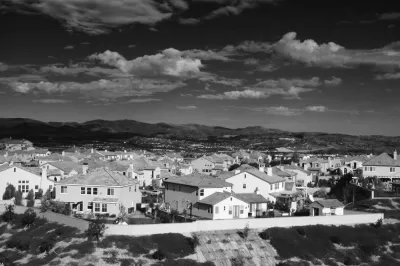What motivates sprawl? It's more than just automobile infrastructure.

I have a mental conception of what sprawl looks like: mostly air with vinyl exoskeleton and asphalt driveways—the ubiquitous 'burbs. Professor Michael Lewyn listed some of its agents in his recent piece for Planetizen, "How to Teach About Sprawl (and Law)." He primarily focuses on the usual spatial suspects: wide (too wide) streets and lots for (too) big houses. In this picture sprawl is largely associated with the 'burbs and big box stores, an "inefficient" use of land. Here I'll go into what enables the spatial actants.
In his book, All Over the Map, architect Michael Sorkin critically explores some of the agents that give cities their form. He asks us to look beyond the architecture of cities and inquire into the complex histories of them. In his essay exploring the physical and figurative Manhattan crater of 9/11 he writes, "The suburbs were fertilized by massive government intervention in highway construction, by radical tax policy, by changes in the national culture of desire, by racism, by cheap, unencumbered land, and by an earlier fear of terror."
Sprawl isn't simply design standards that require wasting land—for example, driving lanes that are substantially wider than vehicles, surface parking lot built to meet Christmas shopping peak demand, or McMansions that waste land (as much as they do air)—but something more holistic and nuanced. Sprawl is a socio-political-economic web complexly intertwined and interconnected, often messily and incomprehensibly but sometimes parsed by the bright ones scraping away the surface for deeper explorations.
As Sorkin writes, the fear of a terror attack induced policies for de-densification. Where we lived and worked needed to be designed to make for quick evacuations. The prospect of nuclear annihilation made urban concentrations particularly vulnerable. As GlobalSecurity.org reveals,
When President Eisenhower went to Kansas to announce the interstate highway system, he announced it as “the National Defense Highway System.” In 1956 [he] signed legislation establishing the National System of Interstate and Defense Highways (about 41,000 miles of roads). Since then, [Department of Defense] has continued to identify and update defense-important highway routes. The National Defense Highway system was designed to move military equipment and personnel efficiently.
Of course, The National Defense Highway ensured transportation routes was good for the automobile industry too. The massive de-urbanization in Maoist China was also the direct result of nuclear anxiety, Sorkin reminds us.
The typical dialectic of city versus suburb, however, is operationally meaningless when we explore a finer resolution for sprawl's agents: Our personal desire for a chunk of land, and the dominant mode of transportation that takes us from property chunk to property chunk; technologies that problematize the need to be a pedestrian to access businesses (the market-place ballet has been scrubbed by clicking and purchasing via intertubes).
There's also the financial system's need to sprawl. Capital ultimately gets laid down in bricks and mortar. Capital is any asset that generates a financial return. Real estate is physical capital, a place where money becomes something physical to earn a rate of return. Financially diagnosed cheap farm land, aided by government incentives, makes for a good return on investment. (The housing market in London or Vancouver isn't much interested in supplying a housing stock for its population, but that's another story.)
What we build is not detached from nature; it's getting laid down in the geological strata, which is amazingly disturbing. But I'll look at the Anthropocene epoch, and problematize it, in a future post. In brief, yes, sprawl is bad, and we need to explore and ultimately resist its agents. We live in an ecological system where we can't fully know how much damage we can do to it before it collapses. When we starting thinking about the complex mosaic of sprawl we begin to see its puppeteers. Don't be a puppet.
Connect with Steven on Twitter @stevenpsnell or Facebook stevenpsnell. Download his novel, Clear Running Water, at Smashwords.

Trump Administration Could Effectively End Housing Voucher Program
Federal officials are eyeing major cuts to the Section 8 program that helps millions of low-income households pay rent.

Planetizen Federal Action Tracker
A weekly monitor of how Trump’s orders and actions are impacting planners and planning in America.

Ken Jennings Launches Transit Web Series
The Jeopardy champ wants you to ride public transit.

California Invests Additional $5M in Electric School Buses
The state wants to electrify all of its school bus fleets by 2035.

Austin Launches $2M Homelessness Prevention Fund
A new grant program from the city’s Homeless Strategy Office will fund rental assistance and supportive services.

Alabama School Forestry Initiative Brings Trees to Schoolyards
Trees can improve physical and mental health for students and commnity members.
Urban Design for Planners 1: Software Tools
This six-course series explores essential urban design concepts using open source software and equips planners with the tools they need to participate fully in the urban design process.
Planning for Universal Design
Learn the tools for implementing Universal Design in planning regulations.
Ada County Highway District
Clanton & Associates, Inc.
Jessamine County Fiscal Court
Institute for Housing and Urban Development Studies (IHS)
City of Grandview
Harvard GSD Executive Education
Toledo-Lucas County Plan Commissions
Salt Lake City
NYU Wagner Graduate School of Public Service




























